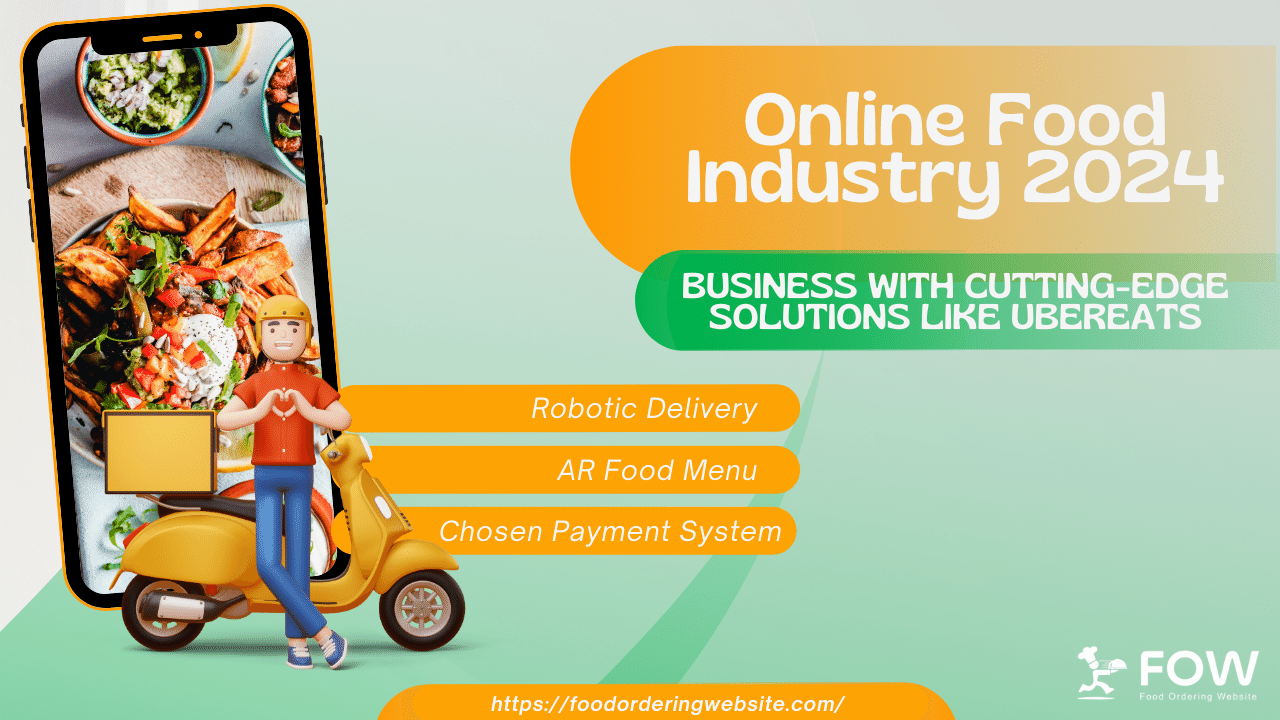The online food industry is changing and evolving fast, with all the technological supports, strategies and financial methods included. A wide range of innovative solutions are coming up making the market all the more enriched. At the very heart of this rising trend is the rapid growth of customers willing to order food items online.
What is the market segmentation of food delivery?
By 2024, the market for meal delivery services will have a user penetration rate of around 27.5%.
The reasons may be varied, from busy lifestyle to the inability to cook lengthy dishes due to various problems, but the solution seems to be one for them, ordering the food online through the apps and getting them within a very small amount of time. Because of this demand, the entire food market is getting changed fast. In 2024 the following trends have already hit the market. Let’s check them out.
Lists of Trends and Innovations: What is the Function of Food Delivery Services?
Drone Delivery:
Drones are changing Online Food Industry. This technology offers quicker, more efficient distribution, revolutionizing commodity transportation. In difficult terrain or congested cities, drones may reduce delivery times and expand radius. Speed is a major advantage of drone food delivery. Drones fly straight to their destination, avoiding traffic and delays. It may take less time for food to reach customers. Drones can readily reach remote areas.
Rural, hilly, or busy city regions may be reached rapidly by drones. This extension delivers meals quickly to underprivileged areas. Drones provide meals swiftly and reduce transportation’s carbon footprint. Unlike gas-powered autos, electric drones lessen delivery companies’ environmental impact.
Robot Delivery:
Food distribution is changing unexpectedly with robotics. Traffic and delivery of our favorite delicacies are no longer under human control. Future delivery robots will transform customer expectations and delivery procedures. A good example is sidewalk robots. Small self-driving vehicles carry restaurant orders to customers’ doorsteps via sidewalks and pathways. Modern sensors, cameras, and mapping software let them navigate obstructions and traffic restrictions safely and quickly.
Starship Technologies and Kiwibot, with robots in many cities, are leading. Food deliveries may reach driverless vehicles from sidewalks. These larger, self-driving cars handle traffic and extended travels. Domino’s and Nuro are developing autonomous delivery vehicles to deliver food to our doors.
Smart Home Synced Online Food Order:
Technology is becoming more prevalent at home. Smart home technologies and online meal ordering platforms are making food ordering easier than ever. Imagine returning home after a long day, expecting a delicious supper but loathing menus and online platforms. Say “Hey Google, order pizza from my usual place” o “Alexa, I’d like to order sushi for dinner.” The smart home device connects to your favorite meal ordering site using voice recognition.
View previous orders and browse the menu on your smart home device. You may pick, amend, and pay securely using pre-saved payment information without leaving your couch. Busy families and individuals avoid managing several devices or entering complex requests with this hands-free solution.
Smart Kitchen Synced Food Delivery:
Smart kitchen synchronization will change food delivery and preparation in the Online Food Industry. Real-time food delivery services interfacing with smart kitchen equipment would revolutionize order-to-plate. New technology simplifies, speeds up, and adds futuristic magic. Computer-guided cooking is one way. Your smart refrigerator may acquire menu and ingredient information after ordering. After connecting, your smart oven or stove may suggest cooking settings based on recipe and equipment.
This guarantees easy, well-prepared meals without searching online or via recipes. Smart kitchen synchronization may change delivery times. A smart oven can notify the delivery service when it’s ready to prepare supper. The food delivery platform may adjust the delivery window to assure a hot and fresh supper.
Evolution of the Food Apps: Features of Food Ordering System
Innovation helps culinary app makers remain competitive in a changing market. Key changes in these firms:
Enhanced Personalization:
Modern meal ordering is more personalized because to machine learning and data analytics. Instead of merely listing restaurants and cuisine, food apps are becoming complex platforms that cater to each user’s preferences. This customisation analyzes massive user data using machine learning. culinary apps may inquire for your location, culinary preferences, and dietary restrictions.
Personalization is based on app use over time. When you browse a menu, order, or review, the app gathers important data about your preferences. From this data, machine learning algorithms detect patterns in your picks. Do you order Thai on rainy days? Do you order the same breakfast burrito? For health, you may prefer smoothies and veggies.
Improved User Interface:
An enjoyable online food ordering experience hinges on the UI. A simple, well-designed UI links customers to their meals, simplifying the purchase. Imagine using a cluttered UI with text-heavy menus and ambiguous layouts. A terrible encounter would cause discontent and order cancellation. A simple UI makes menus appealing with high-quality visuals and concise text. This allows individuals quickly evaluate options and make informed decisions. Additionally, simpler UIs emphasize usability. Ordering should be straightforward with simple choose, personalize, and pay options.
A user-friendly interface is essential for computers, tablets, and smartphones. Real-time delivery tracking in Online Food Industry pleases customers. A good UI enables customers track their order’s arrival and prepare for their dinner. Control and transparency enhance user experience.
Integration of Augmented Reality Menu:
Imagine a hot Pad Thai on your table before ordering. Restaurant ordering apps may be more engaging using AR. AR overlays digital elements on reality via a smartphone camera. AR Menu App System bring 3D menu models to your kitchen or dining room for food orders. You may digitally “place” food on your table to receive a realistic feeling of its size, presentation, and even scent (with integrated smell technology, presently under development). This graphic facilitates choice.
Users may get a better idea of the dish’s appearance and size than just photographs and descriptions, helping them choose based on their likes and location. Visual AR may be interactive. Consider rotating the virtual dish or focusing in on the components. Interaction may make ordering more enjoyable and engaging.
Seamless Payment Integration:
To eliminate friction and simplify checkout, food app developers must incorporate secure payment channels and digital wallets. These companies may provide customers several payment options while securing their financial data with trustworthy payment providers and good encryption. Digital wallets encrypt payment information and make transactions with a few taps.
This boosts consumer satisfaction and app security confidence. As cyber dangers increase, food app developers must emphasize secure payment options to safeguard user data and brand reputation.
Social Media Integration:
Social media integration in Online Food Industry lets food app users share their meals, suggestions, and reviews with friends and followers. Food app developers leverage Facebook, Instagram, and Twitter to provide user-generated content. This relationship increases app ecosystem community and word-of-mouth marketing. Users may easily submit food photos, rate restaurants, and tag friends to invite them, creating a lively scene.
Social media integration increases restaurant visibility and may attract new customers via shared content and positive reviews. Social media increases app growth, user engagement, and community involvement.
Customer-friendly App Features
When it comes to the app features, most of the apps like Uber Eats and Grubhub follow the current app trends. It is a fact that over 50% of the people spend more than 4 hours a day surfing on the smartphones looking for new services.
Therefore, better user experience is always essential in these cases. If the app is not user friendly enough, then the attention of the customer diverts soon to the other apps. This is where the following features are ensured to make the app all the more customer friendly.
Real-time Order Tracking:
Real-time delivery timings and driver locations are essential for transparency and decreased delivery anxiety. Food app developers in the Online Food Industry create confidence by giving customers real order monitoring. Real-time information from confirmation to doorstep provide customers peace of mind. Knowing when their food will come helps customers plan and eliminates delivery uncertainty.
Live monitoring holds delivery suppliers to deadlines, promoting responsibility and reliability. Companies may manage customer expectations and lessen discontent during delays and unexpected issues by providing real-time information.
Customizable Preferences:
Personalized meals by spice level, toppings and amount size enhance the eating experience and promote customization. Customers may customize their meals following the food app developers’ broader customization options to fulfill their requirements and diets. The available customization helps customers make some alterations in their meals according to their food constraints, so that they can enjoy eating. The customer is able to choose all the toppings, the spice level and the amount size of any food item; therefore, he can find it tastier.
Allowing orders to be customized makes the customers feel as though they are in control of their meal and could have it prepared their way. Customized food applications increase user satisfaction and recurrent usage, since consumers choose a platform that accommodates their tastes. This increases user engagement, customer loyalty, and hence competitive positions of the food delivery applications developers.
In-App Customer Support:
Use live chat or chatbots in the app to swiftly handle client issues, enhancing user satisfaction. Food app developers provide real-time communication channels in the app UI to assist users resolve difficulties without visiting external support platforms. Live chat enables customers address issues with customer service in real time.
Purchase queries, account management, and service evaluations may be handled quickly without disturbing the app. Chatbots answer common queries quickly and 24/7. Chatbots may employ natural language processing and programmed responses to give tailored assistance, debug, and escalate complex issues to human agents.
Rewards and Loyalty Programs:
App rewards and loyalty schemes in the Online Food Industry boost repeat purchases and long-term engagement and retention. Food app developers provide discounts, freebies, or exclusive privileges for regular usage or spending milestones. Customers feel cherished and rewarded by loyalty programs. Users prefer the app over competitors when ordering meals because they gain points or rewards.
By identifying customer behavior and preferences, loyalty programs may help companies customize offers and promotions. Rewards and loyalty programs promote mutually beneficial user relationships to help the app prosper in the competitive food delivery sector.
Nutritional Information:
Provide precise nutritional information for menu items to help people make educated dietary and health decisions. Food app development businesses help customers choose meals that meet their nutritional needs by giving explicit information like calorie counts, macronutrient breakdowns, allergens, and ingredient lists.
Transparency encourages healthy eating and fosters customer trust by showing a dedication to their health. Users with gluten-free, vegetarian, or vegan diets may find acceptable selections without searching menus or contacting customer care.
Why Food Ordering Website is the Best One Stop Solution for All Kinds of Food App Development
Its full feature set, state-of-the-art technical integration, and customer satisfaction level collectively brand the App as the best one-stop shop in developing a food app. Based on trends, it is improved in the App so that the consumers and food service operators find unrivaled conveniences, accessibilities, and reliability.
Food Ordering Website predict and serve the best needs of customers; they provide drone delivery, robotic offering, and smart home and kitchen synchronization. It’s the go-to place for easy, fun food ordering with its user-friendly design, personalized recommendations, and smooth payment integration.
Continuous improvement and focus on the customer help Food Ordering Website stay ahead with innovative solutions, aligning with current trends and technology to deliver maximum value to the end-users. And not only delicious food from the present list, Food Ordering Website represents an ideal for any gastronomic whim, both for everyday cooking and sumptuous feasts.
Conclusion
The year has started and already a great many surprises are underway. If you consider to be a part of this online food industry by launching your own food app, then considering the aforementioned information and data is quite useful. Keeping all these in mind, choosing a premiere App development company such as Food Ordering Website happens to be the best decision.
So why wait? Buckle up and start your business journey with the best food app made from Food Ordering Website! Turn your dream to reality today!


